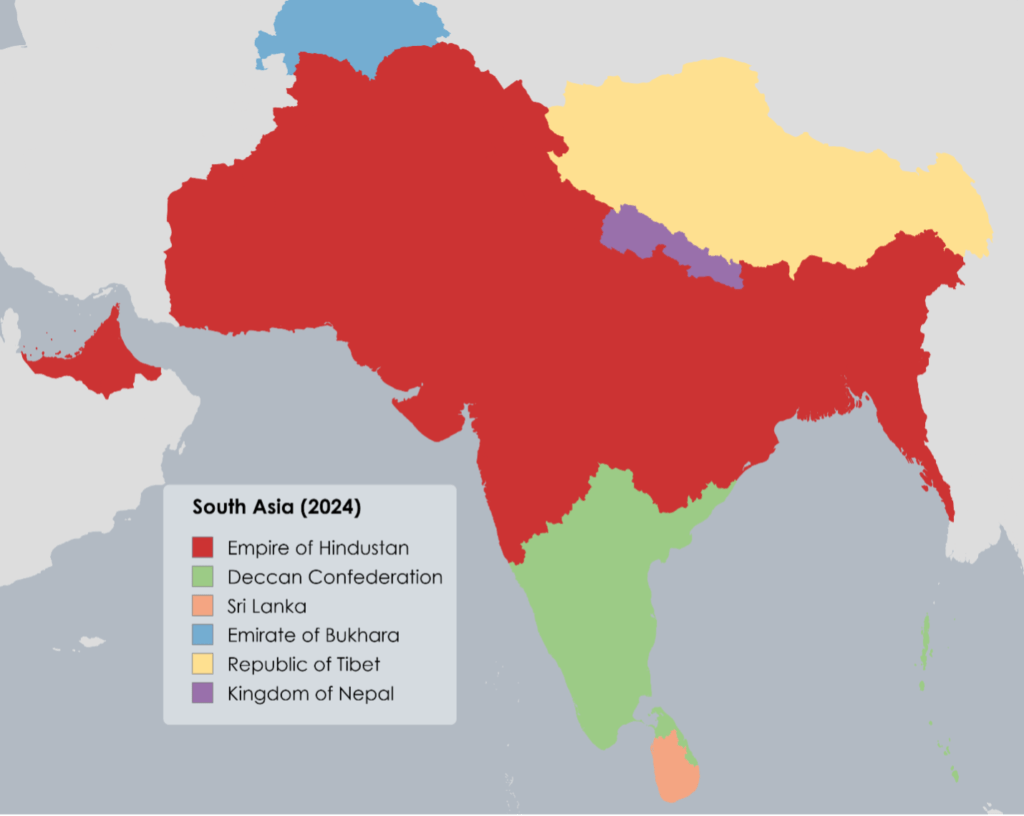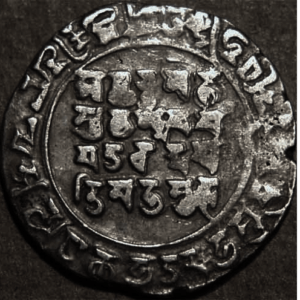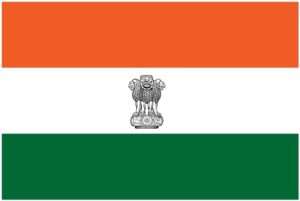Word Count: 3911 | Reading Time: 14 min
Empire of HindustanMotto: ekam sat vipra bahudha vadanti (Sanskrit)
Capital: Delhi Shareef Official languages: Hindustani Demonym(s): Hindustani, Indian GDP nominal: 38.8 trillion Rupees (2023 est.) Government: Parliamentary Constitutional Monarchy Monarch: Shamsuddin Ganesha VIII Prime Minister: Mullah Ashish Kumar Currency: Hindustani Rupee Driving side: Right Calling Code: +4 Time zone: UTC+4:30 to UTC+6:30 |
Vidya Sagar
The Free Encyclopedia
The Empire of Hindustan is a parliamentary constitutional monarchy roughly covering the northern part of the Indian subcontinent. It is the largest country in the world by population as well as the largest economy in terms of nominal GDP, although USA and the German Empire have high per capita GDP. Along with the Deccan Confederation, it is one of the two major powers in the South Asian region. Before the 1812 constitutional reforms, it was known as the Genesha Sultanate, named after its eponymous founder Raja Ganesha. The Capital is Delhi Shareef, the largest cities are Kolkata, Lahore, Mumbai, and Dacca. The country has an exclave in the Arabian Peninsula, the Khaleej Province.
History
Early History
For history of Hindustan prior to the Ganesha dynasty, check out the article on History of India
Origins of the Ganesha Dynasty
The early 15th century was a period of chaos in Northern India where several dynasties followed one another in rapid succession. The chaos was set in motion with the conquest of Delhi Sultanate, ruled by the Lodhi Dynasty, by the Central Asian warlord Amir Zahiruddin Babur who founded the short-lived Mughal Dynasty (1526-1540). It was followed by the Sur Dynasty (1540-1555), Puran Das Dynasty (1555-1569), Afridi Dynasty (1569-1581), and finally the Habashi Dynasty (1581-1587). The order was finally restored when the Sultan of Bengal Sultanate Jamaluddin Ganesha captured Delhi and ushered an era of domination of native Muslim rule. The House of Ganesha was initially the second dynasty to rule the Sultanate of Bengal. The rule of Raja Ganesha (reign. 1414-1419) and his son Jamaluddin Shah (reign. 1419-1444) did not last long though. It is Raja Ganesha’s great-great-grandson Zahiruddin Ganesha who is considered by most historians to be the second founder of the dynasty when he captured Murshidabad, the capital of Bengal Sultanate in 1518. The rule of Jamaluddin and his son Nizamuddin Ganesha is considered pivotal in the history of the subcontinent and beginning of the idea of Hindustan as a nation-state and a civilization state.
The Golden Age (1603-1698)
Nizamuddun’s rule was followed by three equally capable rules. The synthesis of Indian and Islamic, especially Persian art and architecture was in full swing. It was in this era that we find the greatest expression of Ganesha art: Jamia Masjid Delhi, Hathi Minar Lahore, Grand Observatory of Murshidabad, Surya Mandir Multan, and the Tomb of Jahan Ara Meenakshi Begum. Persian started to lose favor among the ruling elite by the end of the 17th century. For a brief period Persian, Hindustani and Bengali vied for influence in the Ganesha court. The golden age came to an end with the ascension of Sultan Shamusuddin Jahan Soz Ganesha The Scourge of God. Hindustan’s national dish Biryani arose as an amalgamation of Persian, Indian and Central Asian culinary influences. The Navya-Nyaya school of Indian philosophy was revived in Delhi. The most interesting intellectual development of this era was the development of many valued logic by Allama Rabindra Rehmanpuri and his student Muhammad Selim Lahori. Nanak Panthi sect of Hinduism started to grow in the Punjab and Sindh regions. Great observatories were built in Banaras and Mathura. Based on many years of observations the celebrated Indian astronomer Kamal Krishnamurti, originally a Tamil transplant from South India, discovered the laws of planetary motion.
Jahan Soz – The Scourge of God (1698-1728)
Jahan Soz is a rare individual not just in the history of India but in the history of the world. He was the youngest nephew of Allauddin Ganesha. Highly capable, intelligent with a fiery temper, he is often compared with the Ottoman Sultan Selim the Grim because of his temper. After the death of Allauddin, the empire was engulfed in the usual succession wars between his sons. Jahan Soz initially sided with his cousin Hamza Ganesha against his brother. When it appeared that Hamza Ganesha would be crowned as the next king, Jahan Soz had him killed along with all potential male claimants. With the empire firmly in his grip, Jahan Soz launched campaigns of conquest across India and Beyond. The Ganesha invaded and sacked Toungoo dynasty’s capital Bagan (modern day Burma) in 1699. In 1702, the Safavid Shah had insulted the Indian Ambassador in a drunken stupor. In a fit of rage Ganesha gathered a massive army and launched invaded Iran through land and sea for the first and only time in history. The five-year war was devastating, the end of the Safavid was swift and Ganesha installed his youngest son Abbas Ganesha as the Shah of Iran. The cadet branch of Ganesha lasted until 1776 in Iran. After the conquest of Iran, Jahan Soz set his sight of the rest of Hindustan. However, by this time the Southern states had come to realize that Jahan Soz represented a mortal threat. Two decades of almost constant warfare, the death of 250,000 soldiers, scorched earth tactics later, the conquest of Deccan was complete. For the first time since the time of Ashoka the Great, India was unified as a singly polity but at a high cost. Jahan Soz lived for three more years; unlike other Ganesha rules he was buried in simple grave in Murshidabad. Although, most of Jahan Soz’s conquests did not last, his wars of conquest led to lasting political changes in India, Burma, and Iran.
Decline (1728-1779)
The death of Jahan Soz was followed by widespread rebellions in the newly conquered territories, the control of the traditional provinces became tenuous as local governors became effectively independent, giving only lip service to Delhi. Even the governor of Bengal, the traditional Ganesha heartland, stopped paying taxes. By 1749, the Emperor of Hindustan was effectively the titular ruler with his rule limited to just a few dozen miles in the vicinity of Delhi. Internecine warfare between the various ‘governors’ of the provinces looked very similar to the Taifa period of Spain, following the collapse of the Umayyad rule. Two dozen emperors ruled the empire in a span of fifty years. The problem was that during the golden age the provinces had gotten fabulously wealthy, but the administration was effectively decentralized so that with a lack of capable ruler the governor of each province was its own ruler. The period is important in the history of India as it was also the period where local rulers patronized vernacular languages in addition to the Hindustani language. Classical works like Heer Waris Shah (Punjabi), Qissa Haft Darwesh (Hindustani), Muhammad Avatara (Bengali) were written during this period. Bulleh Shah also wrote his fifty thousand verse magnus opus Ek Nukta in this period. The Portuguese tried to gain foothold in India but were rebuffed by the Nawab of Bengal in 1754. The Ganesha occupation of Pagan (Burma) lasted from 1699 to 1732 and was met with multiple uprisings. The end came when the Indian army had to retreat to take care of matters at home. The ensuring power vacuum was exploited by the Portuguese who eventually became the colonial rules of Burma. The Ganesha Empire was driven out of Deccan by the combined effort of seven southern kingdoms. The Pact of Odipi (1737) between these kingdoms is considered by many historians to be the precursor to the Deccan Confederation.
Reunification (1779-1833)
 Om written with the Kalam of Bulleh Shah in Persian-Arabic script
|
The reunification of the Ganesha realm was brought not by a strong emperor but by a family of capable Grand Vazir (Rajpramukh) – the Shinde family. The patriarch of the family Dattaji Shinde was the maternal uncle of Alauddin III and served as his regent. Through a series of strategic marriages where he had the young emperor marry the daughters of the nawab of Lahore and the nawab of Prayagraj both of whom did not have any male heirs. This allowed Dataji to take back these two provinces into the imperial fold. Imperial archives later revealed that he had the male heirs killed off in mysterious circumstances. Three generations of the Shinde family waged wars, forged alliances, and by hook or crook restored most of the Empire as it stood before the ascension of Jahan Soz. In 1812, to placate the nobility and get the various semi-independent rulers onboard, the Rajpramukh (Prime Minister) reformed the empire, formalized the relationship between the center and the various provinces. The emperor was still the most powerful man in the empire, but the extent of his power was curtailed. The concept of a national army was introduced which included conscription directly by state instead of forcing individual rulers to raise army for the empire.
Wars with the various polities in Deccan continued with minimal territorial changes. The chance meeting between Dattaji’s grandson Mullah Mohan and the Jesuit priest Charles Xavier is considered by many historians to be a pivotal moment in India’s history. The meeting let to 18-year sojourn of Europe and United States by Mullah Mohan, recorded in his classic travelogue Qissa Haft Minar. Mullah Mohan came back to India with his new compatriot John Marshall who brought a dozens of Englishmen with knowledge of the Power Loom. This would be the beginning of the industrial revolution in India. Conflict with the Portuguese over the Eastern border resulted in the Eastern expansion of the empire as well as the annexation of Portuguese possessions in the Arabian Peninsula. The Arab emirates first became protectorate but were annexed after the imperial reorganization in 1830. The emirs, however, remain autonomous to date.
The Silver Age (1833-1912)
With the ascent of Nizamuddin Ganesha IV, India entered its Silver Age. The administration of the Empire was modernized, suffrage was expanded to include a landed gentry who owned more than 100 acres of land, the country was industrialized, a railroad network linking Kabul to Chittagong was constructed. The onset of World War I (1887-1892) led to the formation of the Hindustani-Ottoman Alliance. The relationships between the two powers had historically been strained since the Nizammuddin Ganesha declared himself as the Calips of Muslims of Hindustan in 1608. A large contingent of Indian soldiers fought to save the Ottoman Empire, an event which is still celebrated in the two empires. The Ottomans formally recognized Hindustani possessions in the Persian Gulf. The Empire used this as an opportunity to annex the various states in Baluchistan as well as parts of the Persian Empire which was on the opposing side of the war. The western modern borders of the Empire of Hindustan were finalized in 1889. Hindustan’s national poet Mirza Ghalib (1797-1833) was also born during this era. Unlike his predecessor, he refused to write in Persian. He would later become the poster boy of the Hindustani language movement, especially after his untimely death because of heavy drinking.
The crown achievement of the Silver Age is of course the Analytical Engine which is now called a Computer. The British inventor Charles Babbage had made remarkable advances in mechanical calculators, but he could not find enough funding and resources in Britain. Akash Chand, the scion of the Jagat Seth had recently converted to Buddhism and was told by a priest that if could write all the names of God then he would become the richest man in the world. When Akash Chand heard of Babbage’ Difference Engine, he offered him unlimited resources and boundless labor to construct his machine in India. Babbage and his assistant Ada Lovelace moved to India to work on this monumental task. Ada Lovelace is better known as Maharani Mehrunnisa Begum, the queen consort of emperor Kamuluddin Ganesha II. Babbage did not live to see the Analytic Engine; it was finally constructed after his death in 1872. The invention of mechanical computers launched the information revolution. It was a period when regional nawabs in Hindustan competed to build the biggest Computers, mainly for bragging rights.
Modern Hindustan (1912-Present)
The short but devastating World War II (1912-1914) was instrumental in the rapprochement of the Deccan Confederation and the Empire of Hindustan. A joint Hindustani-Deccan force occupied Burma and brought the end of Portuguese rule. The European theater front of the war was characterized by massive casualties on both sides, with the Hindustanis committing more than two million soldiers to the Balkans. In the end, the Ottoman Empire was saved, the bond between the two empires cemented. The inter-war period (1914-1944) was characterized by rapid industrialization and urbanization. World War III started with the German invasion of Eastern Europe. Through shrewd diplomacy Kaiser Wilhelm IV had cemented an alliance with Hindustan the previous year. German intelligence had even spread rumors of a personal union between the two empires after the marriage of the Princess Anne with Prince Shamsuddin Ganesha. The German ploy was to use the Empire of Hindustan to fight the Franco-British alliance in their overseas colonies while the Germans concentrated on fighting a two-front war in Europe. Hindustani forces successfully liberated British East Indies and British East Africa. While the colonies liberated by Hindustani forces were soon granted independence, the Germans held onto the colonies that they had conquered from the British, French and the Portuguese. This would later cause problems for the Germans in the 1970s and 1980s as the Americans and the Hindustani supported decolonizing efforts in the various parts of Africa and Asia.
The post-war multi-polar world order has been characterized by three dominant spheres of influence: The American Sphere (North and South America), The German Sphere (Europe, Central Asia, Africa), and the Hindustani Sphere (South, Southeast Asia, Australia). The geopolitical struggle between the three powers has often resulted in multiple proxy wars. The recent war being the Great African War (1995-2002) when the last non-white German colony in Africa (Congo Confederation) became independent largely because of Hindustani-American funding and training local commanders. In the 1950s and 1960s, the Germans and the American supported separatist movements in the Northeastern part of the country. The relationship with the USA has improved considerably since the 1990s. The invention of vacuum tube in 1949 ended the era of giant mechanical computers. Computing, space, and nuclear weapons also became an extension of geopolitics in the post-war world. The Germans have mostly led the world in space race with multiple important milestones: First Satellite in space (1954), First man in space (1957), first woman in space (1958), the first moon landing (1967), and the first human flyby of Venus (1989). Cooperation in space between the Americans and Hindustan started following the German moon landing. Unlike the other two space powers, Hindustan did not develop an indigenous manned mission to the mission, having content with their own space station. A joint American-Hindustani mission finally beat the Germans in the last major space milestone – manned mission to mars in 2015.
The global economic downturn in the 1970s followed cultural revolutions in many parts of the world in the 1980s. The period saw a thaw between the three superpowers as they sought to contain the threat of communist revolutions in these countries. The failure of Engelism to gain a foothold outside of a handful of countries in Africa is a testament to the superpower cooperation in this era. The last major conflict that Hindustan was involved in was the invasion and occupation of Western Australia (formerly Portuguese Australia) with the pretext of the Western Australian government turning genocidal against Aboriginals and Asian immigrants. Illegal immigration from the Emirate of Bukhara, Eastern Turkistan, Western Turkistan, and Burma have become important election issues in the last two decades.

Demographics
The Empire of Hindustan has a population of 1.61 billion which makes it the most populous country in the world. Major religions are Hinduism (1.01 billion), Islam (597 million), Buddhism (44 million), and Christianity (19 million). Hindustani is the lingua franca which is spoken by most citizens. The empire has 28 official languages. According to the 2021 census, 64.2% of the population was urban while the remaining 35.8% lived in urban agglomerations. The literacy rate is 97.2%. Countries with large Hindustani diaspora include Western Australia, Kenya, and Tibet.
International Relations
Deccan Confederation: While the history between the Deccan Confederation and Hindustan was marred by constant strife for centuries, in fact the creation of the confederation of the course of centuries was mainly in response to the expansion of the Empire of Hindustan. However, close cooperation between the two since World War II (1912-1915) has led to cordial relationships. Visa requirements between the two nations dropped in 1954. Although dual citizenship is not allowed, there is free movement of people.
Kingdom of Nepal: The modern state of Nepal has its origins in the ascent of Namgyal Dynasty who came into power after the collapse of Ganesha power following the death of Jahan Soz. The Kingdom made various incursions during the time of decline of the Ganesha Dynasty. Nizamuddin Ganesha IV launched a series of wars to recover the Empire’s former territories. Although he was successful in this task, he was unable to fully annex the Kingdom of Nepal. The conflict finally ended with the Treaty of Darjeeling (1839) where the modern borders between the two countries were fixed. Relationships have generally been positive since then. Nepal emphasizes its Hindu identity to distinguish itself from its larger Southern neighbor.
Republic of Tibet: For the time of restoration of Ganesha power in the early 19th century until the end of World War II, Tibet had to do a balancing act between Hindustan and China. It is a tributary of both the states during this time. When the first Chinese Civil war broke out in 1911, Tibet stopped paying tribute and became a full member of UC (United Counties). Tibet was a backward theocratic state until the Republican revolution in 1948. The Empire of Hindustan maintains multiple army bases in the country, this has deterred China from a full-scale invasion. The two counties have a good relationship, in general the foreign policy of Tibet is aligned with the foreign policy of Hindustan. Additionally, Hindustan pours billions of rupees in aid in Tibet every year to maintain the status quo.
Emirate of Bukhara: The emirate is sandwiched between the Russian Federation and the Empire of Hindustan; it encompasses historic cities like Bukhara and Samarkand. Throughout the second half of the 19th century, the Emirate was a staunch ally of the Empire which provided it manpower and ammunition to resist the Russian incursion into their country. The other emirates in Central Asia were not as lucky as all except Bukhara were gobbled by the Russian Empire by 1869. The German invasion and annexation of the western parts of the Russian Empire during World War III led to millions of Russians migrating to Central Asia. The Empire has three military bases in the country and helps man the border with Russia. The current security arrangement dates to 1992 when Hindustan invaded the Emirate to topple a Russia friendly government.
Iranian Empire: As a consequence of the military adventure of Jahan Soz, Iran was under Ganesha suzerainty for 70 years. Historians consider this period to be the beginning of modernity in Iran as Ganesha rulers upgraded the military, imported talent from Hindustan, and did widespread reforms in agriculture. Relationships between the two empires oscillated between friendship and hostility after the fall of the Iranian branch of Ganesha dynasty. It was the conquest of all of Baluchistan by Hindustan that convinced Iran that they should keep the peace with Hindustan. Surprisingly only a few years after the conquest that Hindustan allied with Iran to defined. Historians speculate that without Hindustani assistance Azerbaijan would have been incorporated in the Russian Empire. The two countries have enjoyed cordial relationships since the beginning of the 20th century. There have been multiple marriages between two royal houses.
Ottoman Empire: The empire has cordial relationships with the Ottoman Empire. The role of Indian soldiers in stemming the tide against the Allies during the first two world wars is considered the single most important factor in the survival of the Ottoman Empire. The Battle of Sofia is commemorated as friendship day in both the countries. Most of the Hindustan Empire’s energy needs are met via energy deals with the Ottomans. After the discovery of oil in the Middle East, the Ottoman Empire became fabulously wealthy, and heavily invested in the Empire of Hindustan.
Culture

| Coin issued (c. 1608) by Nizamuddin Ganesha in imitation of Mehmood Ghaznavi’s coin. The inscription reads: avyaktam ekam, muhamadah avtarah The Invisible is One, Muhammad is the manifestation |
The Hindustani Film Industry, known globally as ML (after Mumbai and Lahore), is considered a global center of culture. The Hindustani film industry is the biggest in the world, followed by Hollywood (USA) and Riowood (South Brazil). Regional film industries like Pollywood in Punjab and Bollywood in Bengal also command hundreds of millions of fans and billions of rupees in revenue. Since the 1990s Dollywood movies (Arabic movies produced in Dubai with an Indian flair) have become popular in the Arab world and the Ottoman Empire, directly competing with the Egyptian film industry. Ramayana and Mahabharat are the national epics of Hindustan regardless of the person’s religion. Like most places in the Islamic world Arabic Calligraphy adorns mosques and holy texts but unlike the rest of the Islamic world, it is often accompanied by the translation of the text in Sanskrit. The rise of Sanskrit as a co-equal language to Persian started during the Golden Age of Ganesha Sultanate, when Sultan Nizamuddin Ganesha revived verbiage of coins from Mehmood Ghaznavi’s reign where the Islamic declaration of faith (Shahada) was written in Sanskrit.
The 1812 reforms relegated Sanskrit, Arabic and Persian to religious and ceremonious roles and Hindustani became the official language of the empire. The usage and prestige of these classical languages have declined since the 1970s as education has pivoted towards STEM subjects. Although, Hindustani is the lingua franca of the Empire, it is written in two different scripts, both of which are taught nationally – the Devanagari Script and the Persio-Arabic Script. The Lucknow Literary Festival attracts hundreds of thousands of attendees every year. The birthday of Mirza Ghalib, the national poet of Hindustan is celebrated with pomp every year and is the day when the government awards in literature and the performing arts. Ghalib was called enfant terrible of Hindustani nobility at the time. His colorful life, innovative poetry, extravagance and opulence of his social cemented his later reputation as a trailblazer of Urdu poetry. The national anthem was written by Iqbal Lahori (1877-1941). In the late 20th century Iqbal mania would sweep the German Empire with translations of Iqbal’s works being widely adapted in songs, dramas and plays. The multi-platinum German singer Wolfgang Iqbal is the grandson of Iqbal and his wife Annemarie Iqbal (nee Steinruck).
The game of Teen Danda (Three bats) is the most popular sport followed by Kabaddi. Teen danda evolved from the ancient Indian sport of Gillidanda. Some historians have argued that the sport may have also been influenced by the obscure sport called Cricket which was played by British merchants in cities like Mumbai and Kolkata. The rivalry between the German Empire and the Hindustani Empire is considered by fans to be the greatest in the game, where matches between the two teams are often considered to be more important than the World Cup itself.

